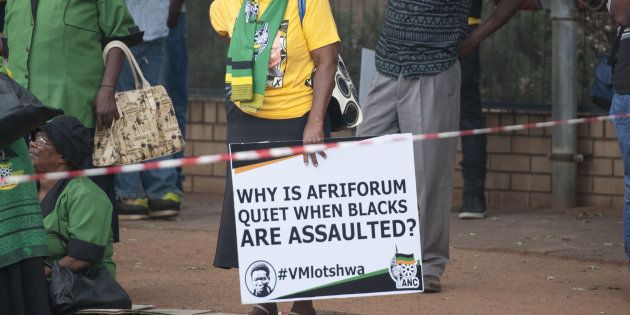
ANC supporters protest outside the Middelburg Magistrates Court during the appearance of Theo Jackson and Willem Oosthuizen, who are accused of assaulting and forcing Rethabile Victor Mlotshwa into a coffin on January 25, 2017 in Middelburg, South Africa.
On 8 February 2017, the South African Institute of Race Relations (SAIRR) released their report on what they say were community perceptions of race and racism in South Africa in 2016. The "Reasons for Hope: Sound, but fraying at the edges" report follows on their February 2016 report and details findings from a small study conducted to dispel popular notions that racism remains a major problem for the country. The reports are both pivoted against the backdrop of one main racist incident – Penny Sparrow's racist rant (aka The Great Monkey Bluster of 2016).
According to SAIRR, the first survey preceded Sparrow's rant, while the second was conducted in part because of the outrage that ensued. The first canvassed views from 2,245 people and the second sought responses from 2,291 people. According to SAIRR, in both surveys, of the people surveyed 78.3% were black (78% in 2016), 9% coloured (9.2% in 2016), 2.8% Indian, and 9.9% white. The findings of both reports are broadly the same, with a few noted discrepancies.
It is unclear whether the same people interviewed in September 2015 were the ones sought out for the September 2016 "re-up" (with the exception, of course, of the additional 46 included in the 2016 survey). In any event, the consistency of the views warrants some scrutiny.

IJR's survey also finds that inequality (more specifically, economic inequality) sows greater divisions than racism. It must be understood that this inequality is still racialised, given the history of how race was used to economically elevate one race over the others.
In short, IJR's survey finds that racism is still a major problem, but SAIRR's says it's not that serious. Same country. Same people. Different findings. So, what gives?
By their own admission, the SAIRR survey set out to counter the prevailing narrative that racism continues unabated in the new South Africa. In giving "reasons for hope," the survey slanted to suggesting that if racism does exist (and according to their report, it is very minimal – or at least people don't see it) then it cannot be systemic or structural. Rather, racism is rare, "isolated", "individual" and often arising from misunderstanding. This flies in the face of social and mainstream media's cataloguing of racism and racist manifestations.
For the SAIRR, people's outrage is amplified through public reporting to a point where racism seems more than it is. According to SAIRR's COO, Gwen Amanda (Sinethemba) Ngwenya, "The hysteria on racism is based on a handful of incidents - Penny Sparrow etc."

To demonstrate this, the SAIRR asked a series of questions to "a carefully balanced sample" (their words, not mine) of people. The survey did not gauge what people understood to be racism, nor whether they distinguished between overt one-on-one racism, inconspicuous racism and broader societal racism.
Supposing respondents answered truthfully, the questions must have put some of them in a quandary. Let's take the following three questions/statements as examples:
- South Africa is now a country for black Africans and whites must take second place
- If you do notice racism in your daily life, in what ways do you notice it?
- All this talk about racism and colonialism is by politicians trying to find excuses for their own failures
"South Africa is now a country for black people" is a blunt statement presented as fact, followed by "whites must take second place." Here, the respondent is not being asked how they define South Africa. Instead, the respondent is put in a complicated position. For starters, they are being told that the country is now (in contrast to the past) a country for black people at the exclusion of other races. Second that by virtue of the country being for black people then that must mean white people are "second class citizens". This is problematic. Respondents were basically asked to agree (or disagree) with one of two things or both, or to neither agree nor disagree with either or both. Complicated, I know.
In short, if you agreed that South Africa is now a country for black people, you were left to pick "agree," BUT doing so would mean you also agree that white people must take second place (no mention of other races...). So, it is difficult to know whether respondents to this question were agreeing to both parts, one part or just unsure.
Then there is, "If you do notice racism in your daily life, in what ways do you notice it?". This question is the one from which the SAIRR gleaned that the overwhelming majority of people do not experience racism. However, it does not account for the fact that it reduces racism to a series of racist incidents that must be accounted for daily and must be noticed.
The first challenge here is that a person may experience forms of overt racism, but not daily. Their answer then could be "No". A person may also not notice the racism or regard it as innocuous, but does that mean racism didn't happen? The recent incident where a woman was given a lift by a farmer and made to sit in a cage in the back of his truck comes to mind. Neither of the parties (the woman nor the farmer) came out to say they believed what had happened was racist. However, questions were raised – and rightly so – as to whether their views of what amounts to racism weren't flawed.
Interestingly, the SAIRR puts partial blame on social media for people "noticing" racism.
On the farmer's part, his actions were likely consistent with how he treats hitchhikers (the undeniable majority of whom are black) and his "way of life". On the woman's part, being a subjugated and subservient employee, her interactions with white people are likely informed by a skew power dynamic that she now views as normal. So, what would each have said if asked "Do you notice racism in your daily life?"
Interestingly, the SAIRR puts partial blame on social media for people "noticing" racism. "The growth of social media may perhaps have fuelled an increase in racist comments, for which there was less public outlet in the past," the report notes. This could be seen to imply that "private" racism – because it is unseen and unheard by the masses – doesn't really count. The flawed logic that if you do not see or hear something, it didn't happen. Except it did...
Another statement posed as a question was "all this talk about racism and colonialism is by politicians trying to find excuses for their own failures." Here, the people taking part in the survey were confronted with viewing racism through two lenses: the first, racism as colonial; second, racism as a politricking tool. The statement is leading, at best; at worst, it is intentional misdirection. Again, the respondent is asked to agree (or disagree) with two things at once. At the same time, the respondent must situate racism as a political act rather than personal, societal or systemic.
The SAIRR explains that they have posed the same questions and made the same statements in their surveys since 2001. For them, regardless of the contentious nature of these questions and statements, the continued use of the same or similar questions allows the SAIRR to easily compare findings. However, it may be useful to reevaluate this methodology and perhaps forsake the "benchmarks" if that ensures more accurate findings.
This was one of the recommendations that I made, together with the Association of Progressive Communications' Sekoetlane Phamodi at the Anti-Racism Network of South Africa's Colloquium on "Reckoning with race." The event, at which both SAIRR and IJR presented their divergent reports, was hosted in partnership with the Nelson Mandela Foundation and the Hanns Seidel Foundation on 15 July 2016.
But why would any report saying "Don't worry! There's no racism here!" be a problem if the road we're on is towards non-racialism?
Simple: Hard truths are truths nonetheless.
Acknowledging that racism is still a serious problem in a country bedeviled by other socio-economic challenges pushes people who are interested in effecting change to continue to do the hard work needed.
Denying the existence of racism serves little purpose other than to absolve those who perpetrate and perpetuate racism. It is the get-out-of-jail free card many are annoyed they can't use.
Most sinister, though, is that denying that racism is still prevalent ignores the lived realities of millions of South Africans who are now being told what they see, feel and deal with is not racism, but manufactured outrage.
If reconciliation, transformation and non-racialism are the goals, the steps taken must not be whitewashed in a way that has the potential to silence those who acknowledge current hurdles.
